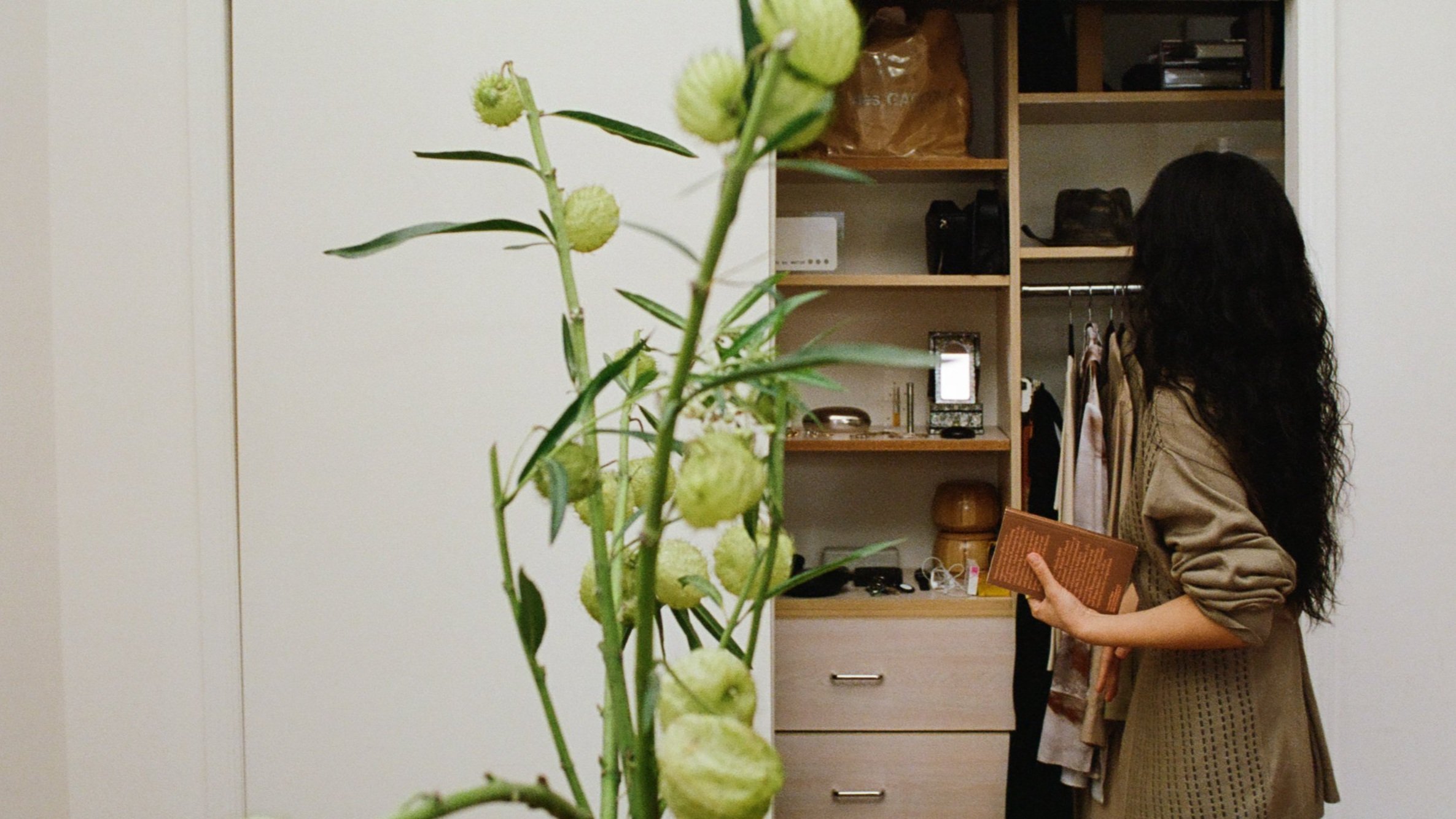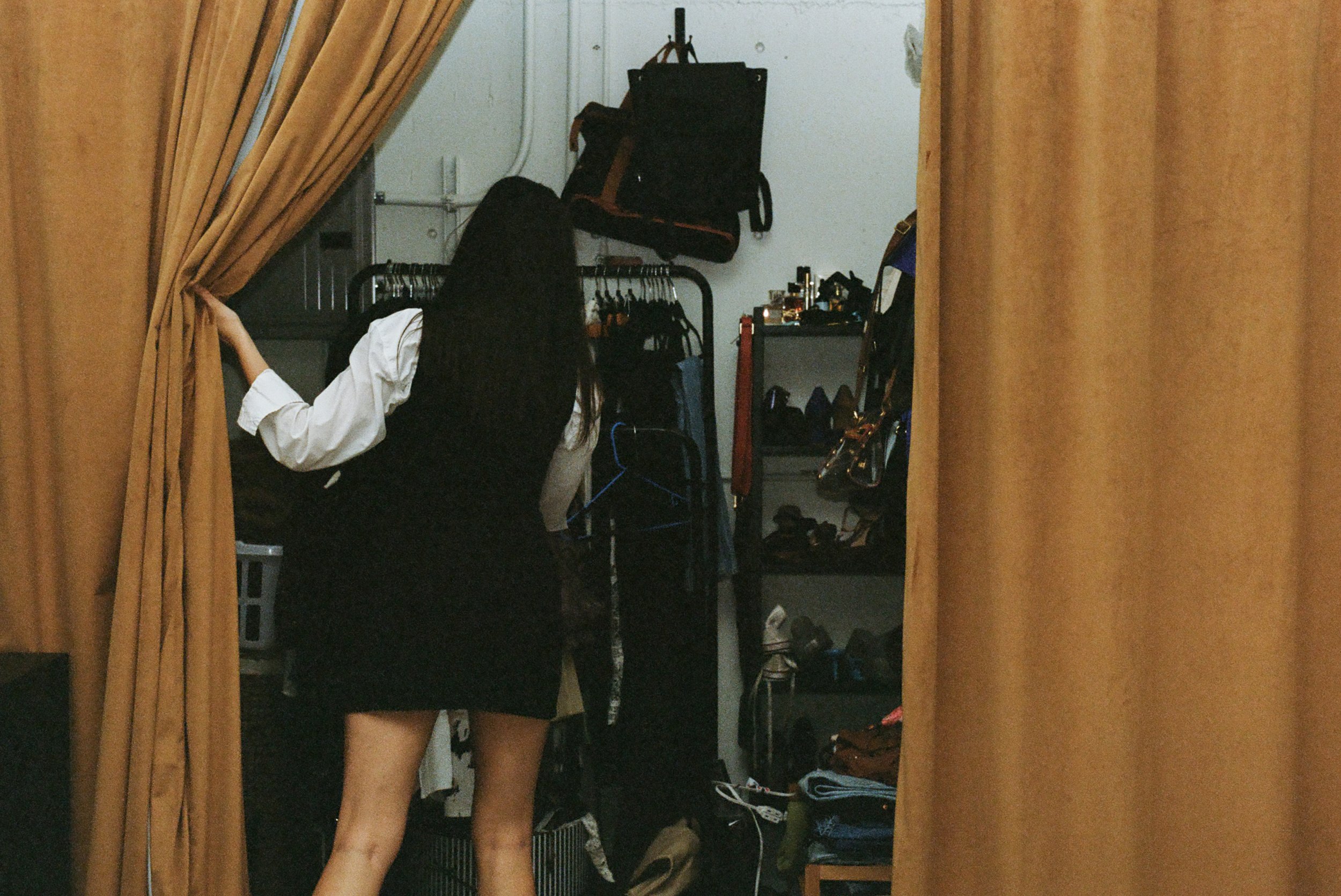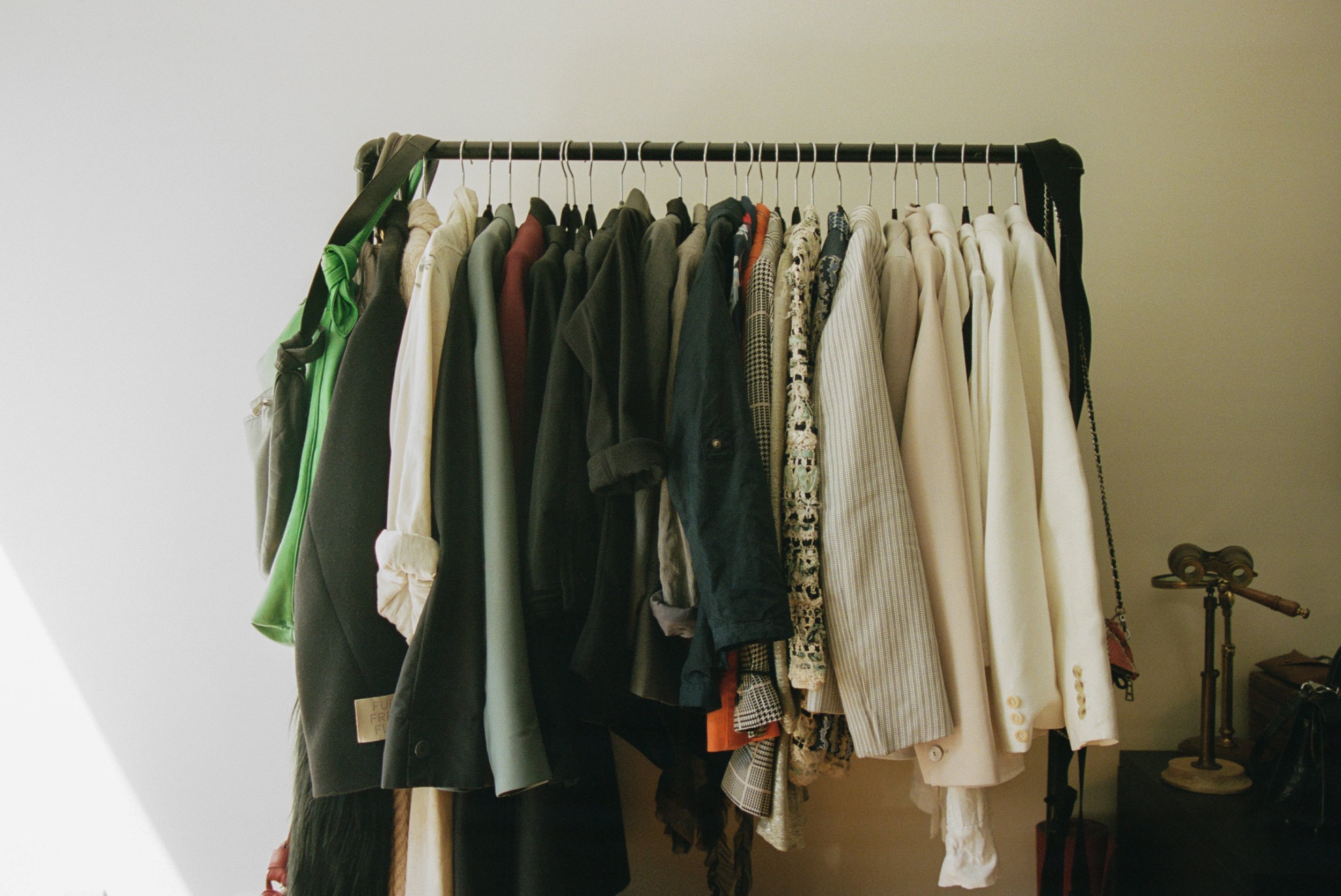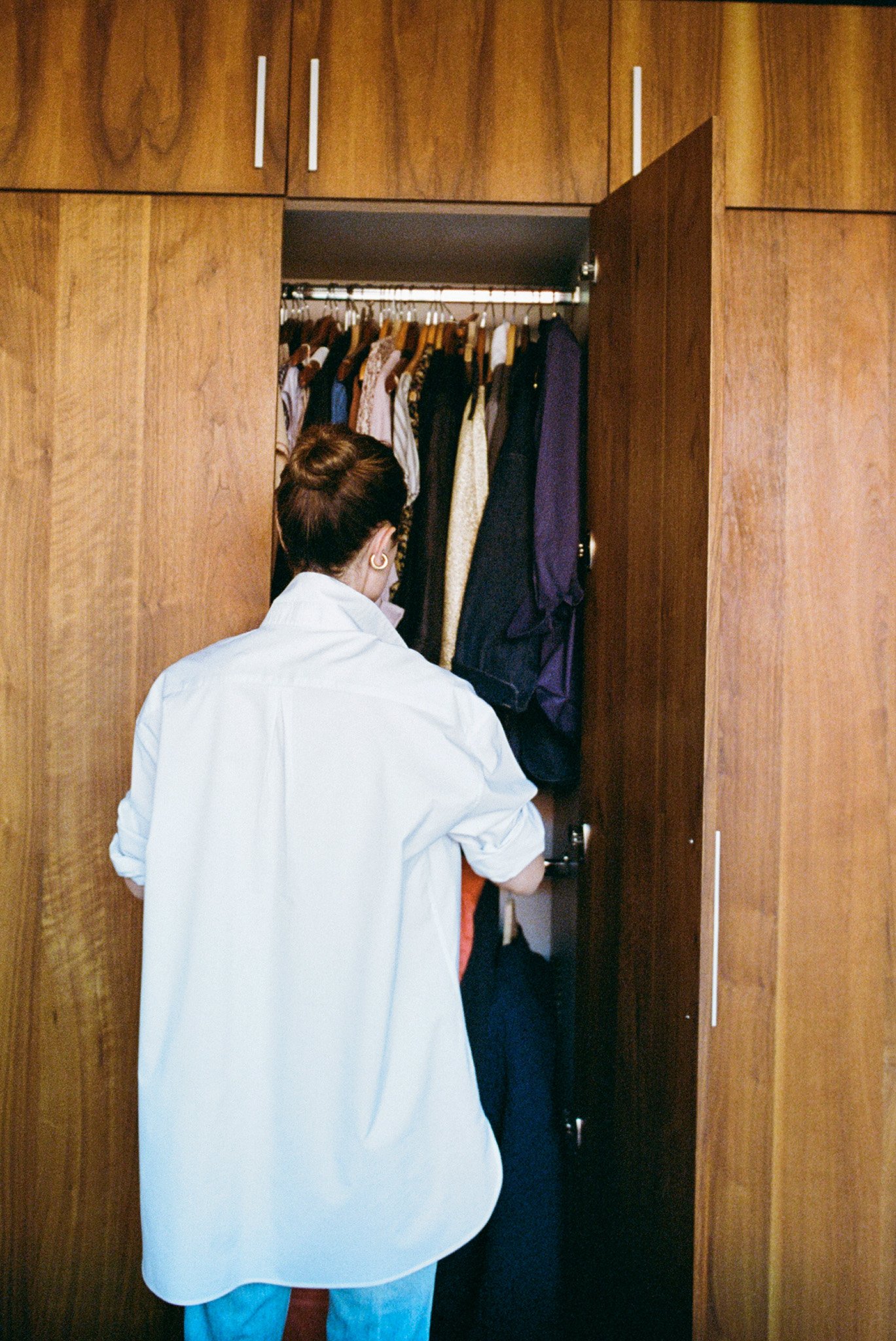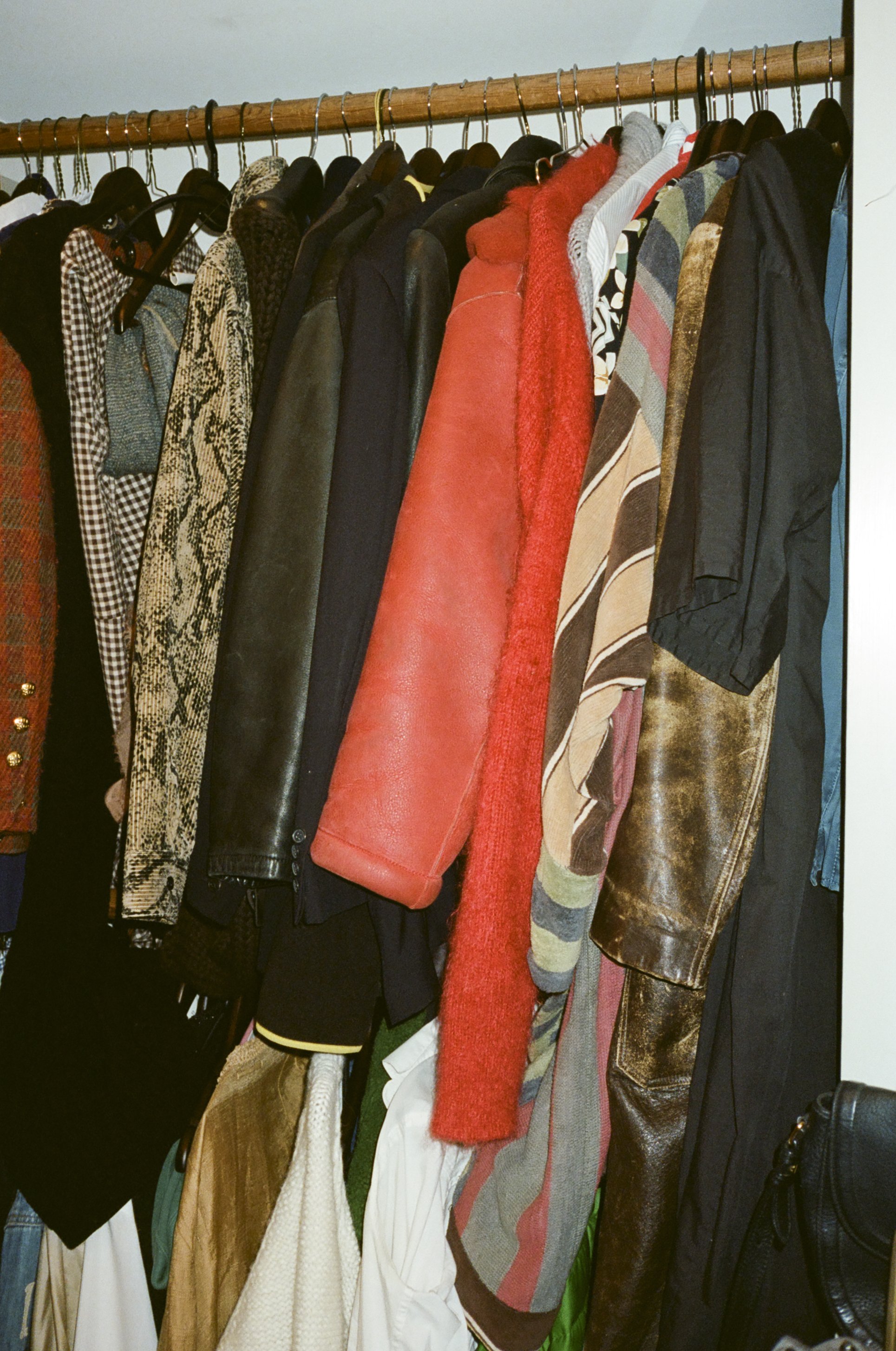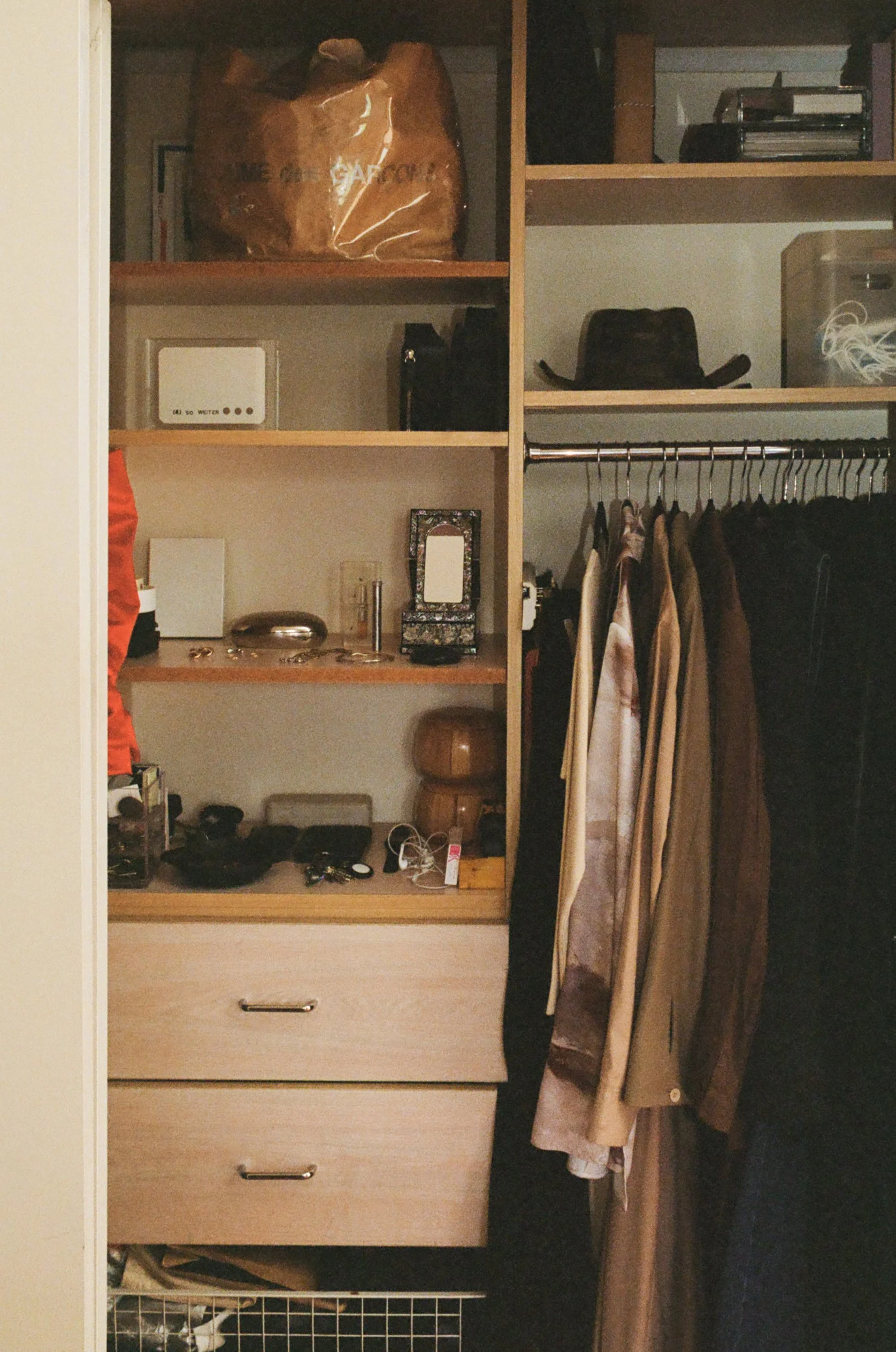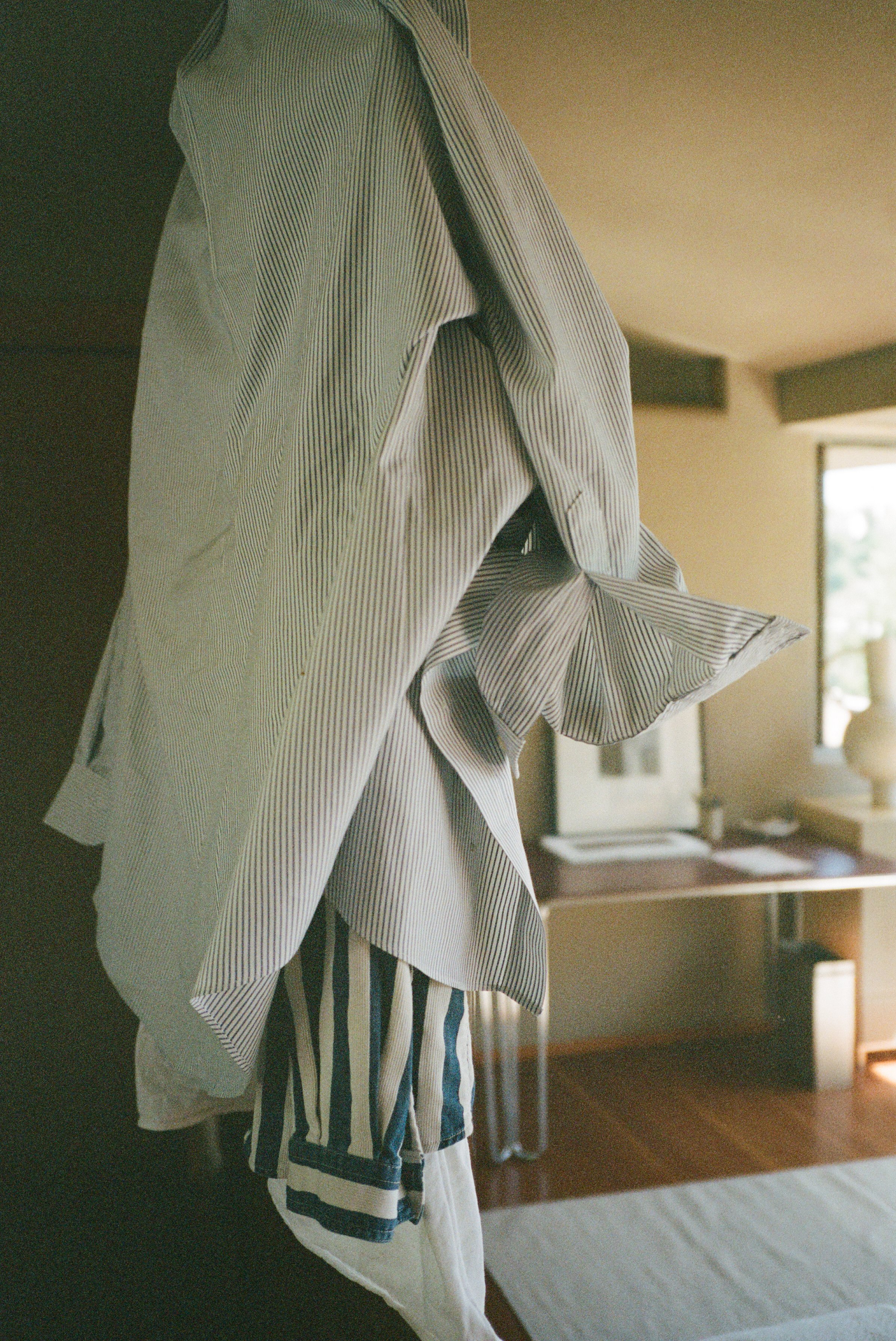a guide to cleaning out your closet
It’s so common it’s a cliché: a woman standing in front of her overflowing closet, having an emotional, spiritual, and practical crisis because she has somewhere to be and nothing to wear. And it’s true, a closet full of clothes you don’t wear can be overwhelming and stressful — but so can the prospect of cleaning it out. In this guide, we consulted three of our favorite experts on getting dressed about how to clean out your closet, from the practical considerations to the philosophical ones.
Getting started
If it’s been a while since you’ve gone through your closet, or if you’re feeling overwhelmed by what you have, getting started can feel daunting. Liana Satenstein, fashion writer and host of #NEVERWORNS, says to just dive in. “I usually just start with whatever is in your eyesight first. It’s the quickest. What is the most visible portion of the closet we're dealing with? If there's a rack of coats, if there's a pile of jeans, whatever it is — I usually just start with whatever is in your eyesight first.”
Subrina Heyink, stylist and writer of the newsletter Are You Wearing That?, says it can also help to “invite a friend. Someone who knows you very well and someone who will be honest with you — not with cruelty, but with vulnerability. Someone who might ask you a question that you might not like but should spend some time thinking about and answering.”
Asking the right questions
Satenstein says “first off, obviously ask yourself the First Commandment question, which is, ‘When was the last time I wore this?’ And then you can dig a little bit deeper from there. Maybe you haven't worn it because it just not comfortable. Maybe you don't actually like the color. Maybe you were scrolling late at night on Instagram, or maybe you bought it not 100% sure about it and had the intention of returning it, but never got to it. Maybe it was some trend that you wanted to sign on to, maybe you bought it for a vacation that you never actually booked the tickets for.” Thinking through the last time you wore an item and why can help you understand how you make decisions when it comes to shopping, which can help you figure out what to part with and how to shop in the future.
Heyink agrees that, “if you have a bunch of things you don't like wearing, you have to think about why.” She says that part of answering this question, and discovering what you really like to wear, is about “assessing the life that you have, the body you have, and what you can afford.” She says that “sometimes dissatisfaction with your wardrobe is not dissatisfaction with your wardrobe, it might be dissatisfaction with your life,” or it might stem from a disconnect between your ideas about your life, the life you actually live, and what you’re comfortable with. She notes, for example, that her style changed when she moved from a larger city to a smaller town — but that even in a more rural setting, “I want to wear something that makes me feel good and sometimes that's wearing heels or stiletto boots to my son's concert recital.” It’s about finding a balance between what you like, what you feel confident in, and what makes sense for your life and your surroundings. If you think through these questions about your life, your body, and your budget, “you're likely to forge a path ahead, because it's not coming from a sense of scarcity,” or a sense of trying to dress for a life you don’t lead. Instead, “it's coming from acceptance and gratitude for what you currently have.” Heyink suggests that, as you ask yourself questions about your closet, “answer in sentences,” instead of narrowly defining your style with a particular label. When you’re working towards a more useful, wearable wardrobe, she says, “what you're trying to get at is, what do you notice about your wardrobe? I need a thesaurus and a dictionary to tell you all of the things I notice about my wardrobe,” and trying to reduce that down to a narrow description or a predetermined aesthetic can feel “just so restrictive. People are spiraling in this very small, restrictive space, instead of opening themselves up to picking and choosing from different spaces and learning about themselves and asking questions and just sitting with the helplessness sometimes, because clothes can cause an existential crisis.” Working through that existential crisis might be part of cleaning out your closet.
At the same time, there are concrete, practical questions that can serve as a guide. Anna Z. Gray, founder of Club Vintage, has a few guiding questions she suggests asking as you move through your closet. “Does it fit you? Can it be tailored? Do you wear it? If the answer to these is ‘No’ then put it in the resale ether.”
What to get rid of and what to keep
You don’t necessarily have to hold onto the things you think you’re supposed to have if you’re not wearing them. Heyink says, “I have a very difficult time with prescriptive dressing. You don't have to wear anything if it doesn't work for you. I feel like saying ‘Everyone should own a button-down shirt, and everyone should have black heels and a little black dress’ sounds good, but then in practice, that's how you get confused because you're looking for the wrong things. I have about seven black dresses, and when they’re hung up, I can’t even tell which one is which, so I forget about them all the time. I'm not getting rid of them —instead, I'm making sure to remember them by organizing my wardrobe differently. But somebody else who's forgetting about their black dresses, it might be because they don't want to wear a little black dress. So you need to figure out what your version of a little black dress is. Why do people say ‘everyone should have a little black dress?’ It’s so you have something to wear to a function that you will always look dressed up in. So, what is that for you?”
Some items can be useful in most wardrobes, but there is room for variation and personal preference. Gray says “basics, to me, are items I reach for when I don’t feel like getting dressed (which happens all the time). Good jeans, good jackets, good shoes. It depends on the temperature outside, but I do think the following are solid wardrobe staples: a trench coat, denim that fits but is comfortable in a medium wash, a black flat (ballet or loafer), a weird jacket for when your base layer is really boring (mine are an orange corduroy jacket and a cropped navy shearling coat).” But what exactly these items look like varies from one person to another. “Knowing what silhouettes you prefer (long and lean, A-line, oversized) is important. Depends on your body and what you deem comfortable.”
You also may need to get rid of less than you think — it depends on what you want from your closet. Gray, for instance, says “I like having options for everything. It really depends on how much you like the process of dressing. If it’s a chore, make your life easier and pare down. If it’s a thrill, I see nothing wrong with owning multiple sequined gowns.” Heyink adds, “I would get rid of some things in a realistic way. Like, am I going to wear these 17 dresses? Probably not, but maybe I’ll wear five. So, keep five and give the rest away. Take the five that you love the most. I've had phases of getting rid of special things, where I was just purging, thinking, ‘I never wear it, someone else should have it.’ And to an extent, you should do that. But don't get rid of all of it.” It can also be an iterative process. Gray says, “I am always on the hunt for the perfect version of things (overcoats, leather pants, snakeskin boots, etc.) and I’ll buy to replace a version I already have, sending the original back into the world.”
Knowing what to get rid of and what to keep is ultimately about knowing what you actually like to wear — what styles, silhouettes, fabrics, cuts. And that knowledge is something that comes with time, practice, and education.
““Sometimes dissatisfaction with your wardrobe is not dissatisfaction with your wardrobe, it might be dissatisfaction with your life, or it might stem from a disconnect between your ideas about your life, the life you live, and what you’re comfortable with.””
The importance of trying things out
Heyink notes that “so much time is spent asking useless questions when the quickest answer is that you must experience by practicing. You have to inform yourself. That's how you learn how to wear a dress that you love but you're not sure how to fit into your life. You practice it. As long as you like it, that's the first step. I can guarantee that most people are buying things they don't like. Everyone's told them what to buy, and they have a lot of tastemakers they listen to so they just collect things. So, you're in a great place if you like, say, this dress. Start there. Try it on one time at home. Something I do sometimes is if it's a shoe, whatever it is, I’ll wear it at home and work in it and just wear it at home. No one can see me. I don't have to be shy. And then I'll wear it out one time.” This, Heyink says, can help build the confidence to integrate items you like but haven’t been wearing.
Satenstein says that getting dressed is “this moment of merging physical with spiritual, because clothes are so interconnected with how we emotionally feel. I would never feel good, for example, in a short skirt, because I feel exposed and it makes me feel insecure. Pay attention to those things and how you react on an individual basis. It's a comfort thing. You have to feel comfortable.” As for how you figure out what feels good for you, she says, “I think part of it comes from trying things out, I’m pro-trying things out. I'm at an age now where I really know exactly how I want to feel and what makes me feel that way, whereas in my early 20s, I'm trying things out, I’m wearing a push-up bra so my boobs are at my chin, and I feel exposed, and I don't feel good about myself, and I don't feel confident. Now I know what I like to emphasize with my body, so I feel better.”
Gray agrees that knowledge of what you like to wear comes with time and experience. Over time, she says, “you’ll inevitably realize and/or come to terms with what you actually wear. Pay attention to it. It’s not a rule — feel free to go weird whenever you want, you’ll learn something there too — but it’s helpful in being conscientious about new purchases and getting dressed. No one can tell you what to wear because your neural pathways, and dressing preferences are your own. There is plasticity there, by the way!”
learn about what you wear
Heyink also notes that it’s helpful to spend time learning about clothes. “People are spending time learning about fashion and the business of fashion, and not about getting dressed because that actually has very little to do with fashion. If you spend less time learning about the history of John Galliano and instead learn what a buttoned placket on a button-down shirt is, you'll figure out how to get dressed very easily, because you'll figure out why things fit the way they do. You can spend a lot of time reading about pleats — I know this because I did. You learn that by paying attention. If you like the way a woman is dressed, instead of coveting the coat, figure out why the coat fits her well. If you figure out why you like the coat, you're likely to go out and not copy that exact coat, but instead, you'll bring that essence.” Too often, she says, people try to copy something exactly or to acquire a specific item they’ve seen. Speaking from experience, she says that many times, “I did acquire those items, and they're just sitting in my closet, I'm not wearing them. I should have focused more on the feeling that that shoe or that dress or the jacket causes me to have than the specific item. It’s about chasing the feeling and not the thing. Because in chasing the feeling, you might end up with something else. Then you've discovered something that's useful to you that you're going to love and use, instead of something that feels good to have in this consumptive way.”
Don’t rush it
It can feel good to spend a day, or a weekend, doing a big closet cleanout, but it’s also a process that can happen more slowly, over time, allowing you to make your closet better, more functional, and more well-suited to your life as you learn more about yourself and what you want to wear. If you’re not sure whether to get rid of something, give yourself some time to see how the piece fits into your life and your wardrobe. Satenstein says “I always say it's good to go through your closet every 2, 3, 4 months, depending on how much you shop. Just take a look to see what you have in there and what you can be wearing and rotating into your present wardrobe. It helps you take stock. Give yourself an ‘expiration pile,’ where you have few days or a week to see if you’ll wear something and figure out how to style it within your wardrobe.” And Gray says, “I have a bag that I toss things into when I’m thinking about recycling them. If I don’t miss them the bag’s contents go to either Club Vintage or another resale site depending on the wear, label, etc.”
Gray also notes that sometimes an item you’re not quite sure about might not be quite right — but it could be perfect with a little help. “I think we hold onto items that we like a lot but don’t quite fit so taking them to the tailor helps. This applies to shoes also. A good cobbler is your best friend.” (If you’re looking for a good cobbler or tailor in your town, we suggest asking for a recommendation in the passerby Discord!).
What to do with the clothes you’re ready to get rid of
There are so many options now when it comes to clothing resale and donation, it can be overwhelming. The decision about what to do with the clothes you’re ready to part with comes down to what you have and how much work you want to do to sell them.
Of the most prominent resale options, Depop, Vestiaire, and The Real Real, Gray says, “the first two let you choose your prices and require low-effort photos,” while on the other hand, “The Real Real is a fully-managed marketplace so you don’t have to take any photos, but they will pick your prices for you.”
But those aren’t your only options. She also suggests “reaching out to vintage sellers that you love. If you have a bunch of old 90s designer clothing that you don’t wear but that they specialize in, they’ll likely offer a bulk buy option and take it all off your hands.” Alternatively, she says, “see if a few of your friends want to do a sidewalk sale and have a donation box for stuff that people can have for free. This is a fun way to meet people!”
And if you want to donate, she notes that “donation places will often come to your house to pick up (google ‘clothing donation pick up in my area’) but request the items are clean and free of noticeable wear like holes.”
Words by meghan racklin

